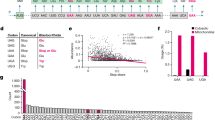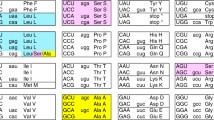Abstract
Tandem stop codons are extra stop codons hypothesized to be present downstream of genes to act as a backup in case of read-through of the real stop codon. Although seemingly absent from Escherichia coli, recent studies have confirmed the presence of such codons in yeast. In this paper we will analyze the genomes of two ciliate species—Paramecium tetraurelia and Tetrahymena thermophila—that reassign the stop codons TAA and TAG to glutamine, for the presence of tandem stop codons. We show that there are more tandem stop codons downstream of both Paramecium and Tetrahymena genes than expected by chance given the base composition of the downstream regions. This excess of tandem stop codons is larger in Tetrahymena and Paramecium than in yeast. We propose that this might be caused by a higher frequency of stop codon read-through in these species than in yeast, possibly because of a leaky termination machinery resulting from stop codon reassignment.


Similar content being viewed by others
References
Aury JM, Jaillon O, Duret L et al (2006) Global trends of whole-genome duplications revealed by the ciliate Paramecium tetraurelia. Nature 444:171–178
Doronina VA, Brown JD (2006) When nonsense makes sense and vice versa:noncanonical decoding events at stop codons in eukaryotes. Mol Biol 40:731–741
Eisen JA, Coyne RS, Wu M et al (2006) Macronuclear genome sequence of the ciliate Tetrahymena thermophila, a model eukaryote. PLoS Biol 4:e286
Inagaki Y, Blouin C, Doolittle WF, Roger AJ (2002) Convergence and constraint in eukaryotic release factor 1 (eRF1) domain 1: the evolution of stop codon specificity. Nucleic Acids Res 30:532–544
Kent WJ (2002) BLAT—the BLAST-Like Alignment Tool. Genome Res 12:656–664
Kisselev LL, Buckingham RH (2000) Translation termination comes of age. TIBS 25:561–566
Lekomtsev S, Kolosov P, Bidou L, Frolova L, Rousset JP, Kisselev L (2007) Different modes of stop codon restriction by the Stylonychia and Paramecium eRF1 translation termination factors. Proc Natl Acad Sci USA 104:10824–10829
Liang H, Cavalcanti ARO, Landweber LF (2005a) Conservation of tandem stop codons in yeasts. Genome Biol 6:R31
Liang H, Wong JY, Bao Q, Cavalcanti ARO, Landweber LF (2005b) Decoding the decoding region: analysis of eukaryotic release factor (eRF1) stop codon-binding residues. J Mol Evol 60:337–344
Lozupone CA, Knight RD, Landweber LF (2001) The molecular basis of nuclear genetic code change in ciliates. Curr Biol 11:65–74
Major LL, Edgar TD, Yip PY, Isaksson LA, Tate WP (2002) Tandem termination signals: myth or reality? FEBS Lett 514:84–89
Massey SE, Garey JR (2007) A comparative genomics analysis of codon reassignments reveals a link with mitochondrial proteome size and a mechanism of genetic code change via suppressor tRNAs. J Mol Evol 64:399–410
Namy O, Hatin I, Rousset JP (2001) Impact of the six nucleotides downstream of the stop codon on translation termination. EMBO Rep 2:787–793
Nichols JL (1970) Nucleotide sequence from the polypeptide chain termination region of the coat protein cistron in bacteriophage R17 RNA. Nature 225:147–151
Salas-Marco J, Fan-Minogue H, Kallmeyer AK, Klobutcher LA, Farabaugh PJ, Bedwell DM (2006) Distinct paths to stop codon reassignment by the variant-code organisms Tetrahymena and Euplotes. Mol Cell Biol 26:438–447
Salim HMW, Ring KL, Cavalcanti ARO (2008) Patterns of codon usage in two ciliates that reassign the genetic code: Tetrahymena thermophila and Paramecium tetraurelia. Protist 159:283–298
Seligmann H, Pollock DD (2004) The ambush hypothesis: hidden stop codons prevent off-frame gene reading. DNA Cell Biol 23:701–705
Williams I, Richardson J, Starkey A, Stansfield I (2004) Genome-wide prediction of stop codon readthrough during translation in the yeast Saccharomyces cerevisiae. Nucleic Acids Res 32:6605–6616
Acknowledgment
This work was partly funded by an HHMI grant to Pomona College’s biology department.
Author information
Authors and Affiliations
Corresponding author
Rights and permissions
About this article
Cite this article
Adachi, M., Cavalcanti, A.R.O. Tandem Stop Codons in Ciliates That Reassign Stop Codons. J Mol Evol 68, 424–431 (2009). https://doi.org/10.1007/s00239-009-9220-y
Received:
Revised:
Accepted:
Published:
Issue Date:
DOI: https://doi.org/10.1007/s00239-009-9220-y




